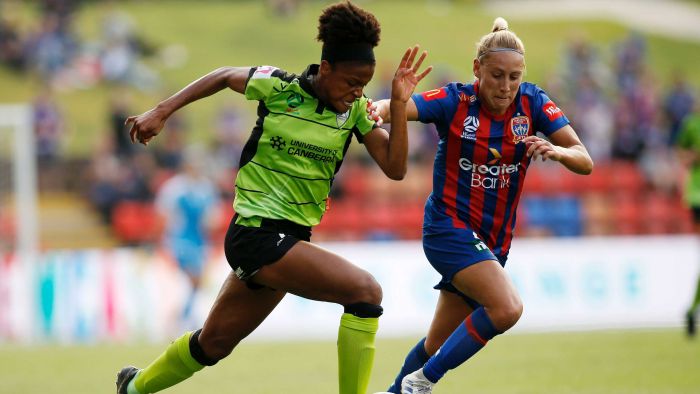There has been a lot of talk about the opportunity for Australian talent to shine in the W-League and A-League this season, with fewer imports or Australian internationals involved.
But is there also an opportunity to further showcase First Nations football this year?
Loading…
Newcastle Jets captain Gema Simon said she would to love to see a permanent Indigenous round implemented in both leagues.
The Gumbaynggirr woman, who has notched 11 caps for the Matildas, told The Grandstand Football Podcast she took pride in representing her community and family.
She also said that a regular Indigenous round would highlight that representation, encouraging First Nations people to dream big in the sport.
“I think that would be incredible, yeah. I’d love to see that in the league,” she said.
“It would be really cool to see some of the jerseys if we did have a round and I think that Indigenous people all over the country would really appreciate that.”
Football Australia (FA) has dabbled with a themed round and partnered with John Moriarty Football in the past for Indigenous Football Week.
But now the A-League and W-League have unbundled from the Australian governing body, it could be an ideal time to start a new tradition.
Other codes doing a better job of inclusion
Former Adelaide United captain Travis Dodd was the first Indigenous player to score a goal for the Socceroos.
Loading
But the Ngarrindjeri, Narrunga and Kaurna man believes football is well behind the AFL and NRL when it comes to engaging with the Indigenous population.
“If you compare the codes, AFL and NRL have been around a long time. Unfortunately, although professional football has been there or thereabouts, the A-League has had its challenges, which has meant they haven’t been able to invest the time and resources into the development of the game at a grassroots level for Indigenous communities,” he said.
The numbers support his argument.
There were 87 Indigenous players on AFL lists last season and 22 in the AFLW.
Rugby league had more than 60 across their NRL and NRLW competitions in 2020, as well as a large percentage of players from Pacific Island or Maori heritage.
But when it comes to the round-ball game, there is a lack of readily available data about how many Indigenous players are signed to A-League and W-League clubs.
The ABC can identify two current Indigenous A-League players — Luis Lawrie-Lattanzio and Tate Russell — and three female players in the current W-League setup — Jada Whyman, Simon and Allira Toby.
A list was requested from the FA but none was provided.
An Indigenous round would need to be more than a token effort: Dodd
Football is not the only Australian sporting code with low Indigenous representation.
Super Netball came under fire last year when the only First Nations player in the league was used to market tickets and promote the importance of its third Indigenous round, but didn’t get a chance to actually play on court.
Loading
Dodd said football needed to be careful not to fall into a similar trap.
“To be able to have an Indigenous Round in the A-League would be fantastic because it would recognise the community, our culture and people that have played the game,” he said.
“It doesn’t necessarily need to recognise players at just the professional level, it would mean something to players at all levels.
“Unfortunately, during my time in the A-League I saw the level of involvement from Football Australia stop and start multiple times … It feels like a flavour-of-the-month-type thing.”
In 2020, Football Australia announced its XI Principles for the future of Australian football with a list of goals to work towards over the next 15 years.
This includes the aspiration to ensure the sport is “recognised as a leader in Indigenous sporting programs and the reconciliation process for Indigenous Australians”.
One of the targets listed to achieve that is to appoint a dedicated resource to lead national Indigenous programs in 2021.
If the FA follow through on that promise, then Dodd said the idea of introducing an annual A-League and W-League Indigenous round would have some merit.
“My scepticism comes from their previous actions, over the last 13 to 14 years,” he said. “There’s been a number of Indigenous football festivals that are always labelled as the start of something great, but it never eventuates.”
“I respect that James Johnson is new in the role as CEO, so he needs to be given an opportunity to fulfill that commitment and with all the challenges going on in the world at the moment, I just hope that it remains a priority moving forward.
“So if the FA do put someone in place to be a coordinator for Indigenous football pathways during this quarter, and we can see continued development in that area — not just press releases to say they’re committing — then I think it would be great to incorporate a fully-fledged Indigenous Round.
“That would then be a celebration of what they’re doing for Australian football and Indigenous footballers, because we can actually see something happening in the background.”







